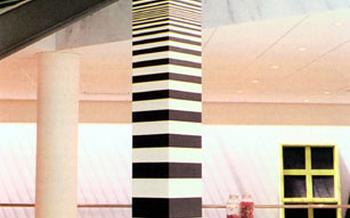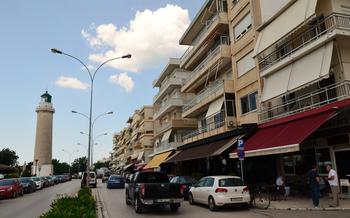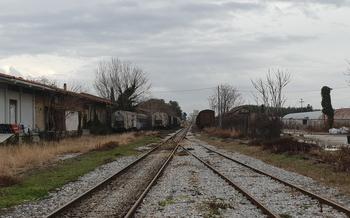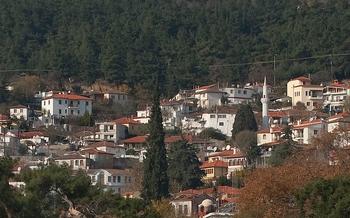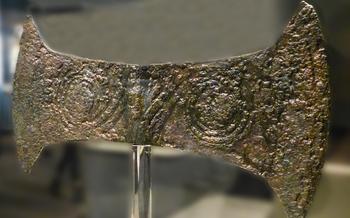
The Natural History Museum of Alexandroupoli
- The Natural History Museum of Alexandroupoli
- Exhibits
- Educational Programs
- Research
- Collections
- History
- Architecture
- Significance
- Location
- Admission
- Hours
- Amenities
- Events
- Contact Information
- Insider Tip
The Natural History Museum of Alexandroupoli
The Natural History Museum of Alexandroupoli is a fascinating institution dedicated to preserving and showcasing the natural history of the region. Established in 1978, this museum has become a significant resource for researchers, students, and nature enthusiasts alike. Situated in the heart of Alexandroupoli, the museum is easily accessible and offers a wide range of exhibits, educational programs, and research opportunities.
The museum's hours of operation are from 9 am to 5 pm, Tuesday through Sunday. Closed on Mondays.
Exhibits
The Natural History Museum of Alexandroupoli features a wide range of exhibits that cover a variety of topics related to the natural world. These exhibits include displays on the geology, flora, and fauna of the region, as well as exhibits on the history of life on Earth. Some of the highlights of the collection include a large collection of fossils, a life-size model of a dinosaur, and a collection of live animals, including snakes, lizards, and turtles. The exhibits are displayed in a variety of ways, including traditional display cases, interactive exhibits, and dioramas. The museum also offers a variety of educational programs for visitors of all ages, including guided tours, lectures, and workshops.
Educational Programs
The Natural History Museum of Alexandroupoli is committed to providing educational opportunities for people of all ages. The museum offers a variety of programs, including guided tours, workshops, and lectures.
Guided tours are available for groups of all sizes and can be tailored to specific interests. Tours are led by experienced educators who can provide insights into the museum's exhibits and answer questions.
Workshops are offered on a variety of topics, such as taxidermy, fossil preparation, and nature photography. Workshops are typically hands-on and provide participants with an opportunity to learn new skills and create their own projects.
Lectures are given by experts in the field of natural history and cover a wide range of topics. Lectures are free and open to the public.
The museum also offers a variety of educational resources for teachers, including lesson plans, activity sheets, and online resources.
To sign up for a program, please contact the museum's education department.
Research
The Natural History Museum of Alexandroupoli is not just a place to admire exhibits but also a hub for scientific research. The museum's researchers are actively engaged in a variety of projects, including studies on the region's biodiversity, the evolution of species, and the impact of climate change on the environment.
The museum's research team is composed of experienced scientists and researchers from various fields, including biology, geology, and ecology. They work closely with other institutions, such as universities and research centers, to conduct collaborative projects and share knowledge.
The results of the museum's research are published in scientific journals, presented at conferences, and shared with the public through educational programs and exhibits. The museum also collaborates with local communities to raise awareness about environmental issues and promote conservation efforts.
If you are interested in learning more about the museum's research, you can visit the museum's website or contact the research department directly. The museum's researchers are always happy to share their knowledge and insights with the public.
Collections
The Natural History Museum of Alexandroupoli houses a vast and diverse collection of specimens from the natural world. The collection includes over 100,000 items, representing a wide range of species from all over the world. The collection is divided into several sections, including zoology, botany, geology, and paleontology.
The zoological collection includes a wide variety of animals, from insects and arachnids to amphibians, reptiles, birds, and mammals. The collection includes many rare and endangered species, such as the loggerhead sea turtle and the European mink.
The botanical collection includes a wide variety of plants, from mosses and ferns to flowering plants and trees. The collection includes many rare and endangered species, such as the Greek orchid and the Macedonian pine.
The geological collection includes a variety of rocks and minerals from all over the world. The collection includes many rare and unusual specimens, such as the meteorite that fell in Alexandroupoli in 197
The paleontological collection includes a variety of fossils from all over the world. The collection includes many rare and unusual specimens, such as the fossilized skull of a dinosaur that was discovered in nearby Thrace.
The museum's collections are used for a variety of purposes, including research, education, and public outreach. The collections are also used to support the museum's conservation efforts.
The museum's collections are accessible to the public through a variety of means, including exhibits, educational programs, and research projects. The museum also offers a variety of resources for researchers, including a library, a herbarium, and a fossil preparation laboratory.
History
The Natural History Museum of Alexandroupoli was founded in 1971 by a group of local scientists and naturalists. The museum's original purpose was to promote the study of natural history in the region. Over the years, the museum has grown and expanded, and it now houses a vast collection of specimens from all over the world. The museum is a valuable resource for researchers and students, and it also plays an important role in educating the public about the natural world.
The museum has undergone several renovations and expansions over the years. In 1985, a new wing was added to the museum, which allowed for the display of more specimens. In 2000, the museum was completely renovated, and a new state-of-the-art exhibit hall was added. The museum now has over 10,000 specimens on display, and it is one of the largest natural history museums in Greece.
Architecture
The Natural History Museum of Alexandroupoli is a stunning example of modern architecture. The building was designed by the renowned Greek architect Dimitris Pikionis, who is known for his innovative use of traditional Greek elements in his designs. The museum is a striking, yet harmonious blend of contemporary and traditional Greek architecture.
The exterior of the museum is characterized by its clean lines and simple forms. The building is clad in white marble, which gives it a bright and airy appearance. The entrance to the museum is marked by a large, arched doorway that is flanked by two columns. The columns are topped by capitals that are decorated with intricate carvings of natural motifs.
The interior of the museum is just as impressive as the exterior. The museum's galleries are spacious and well-lit, and they feature high ceilings that create a sense of grandeur. The exhibits are displayed in custom-designed cases that are made from a variety of materials, including wood, glass, and metal. The cases are arranged in a way that allows visitors to easily navigate the museum and to view the exhibits from all angles.
The Natural History Museum of Alexandroupoli is a unique and beautiful building that is a testament to the creativity and skill of Greek architects. The museum is a must-see for anyone who is interested in architecture, natural history, or Greek culture.
Significance
The Natural History Museum of Alexandroupoli is a significant institution for several reasons. First, it is a valuable resource for researchers and students in the field of natural history. The museum's collections and exhibits provide a wealth of information about the region's biodiversity and ecology. Second, the museum is an important educational tool for the community. It offers a variety of educational programs and events that help to teach people about the natural world. Third, the museum is a cultural landmark that contributes to the city's identity. It is a place where people can come to learn about and appreciate the natural history of their region.
The museum has made significant contributions to the field of natural history. Its researchers have conducted groundbreaking studies on the region's flora and fauna. The museum has also played a key role in raising awareness of environmental issues. Its exhibits and educational programs have helped to teach people about the importance of protecting the natural world.
The museum has had a positive impact on the community. It has helped to create a greater appreciation for the natural world. It has also been a catalyst for conservation efforts in the region. The museum is a valuable asset to the community and continues to play an important role in promoting the study and appreciation of natural history.
Location
The Natural History Museum of Alexandroupoli is located in the city of Alexandroupoli, in the northeastern part of Greece. It is situated on Vasileos Georgiou B' Street, in the city center. The museum is easily accessible by public transportation, as there are several bus stops within walking distance. There is also ample street parking available in the surrounding area.
If you are driving to the museum, take the Egnatia Odos motorway and exit at Alexandroupoli. Follow the signs to the city center and then turn onto Vasileos Georgiou B' Street. The museum will be on your left-hand side.
Once you arrive at the museum, you will be greeted by a friendly and helpful staff. They will be happy to provide you with any information you need about the museum and its exhibits.
Admission
The Natural History Museum of Alexandroupoli offers free admission to all visitors. This makes it a great option for families and individuals who are looking for a budget-friendly activity. There are no discounts available, and the museum does not offer any free admission days. The museum accepts cash and credit cards.
Hours
The Natural History Museum of Alexandroupoli is open to the public from Tuesday to Sunday, from 8:30 am to 3 pm. Please note that the museum is closed on Mondays.
If you are traveling with a group or planning a special event, such as a birthday party or a school field trip, you can book a private tour of the museum. Private tours are available outside the regular hours of operation and can be customized to meet your specific needs.
To book a private tour, please contact the museum's education department at 25510-22934 or send an email to [email protected].
Amenities
The Natural History Museum of Alexandroupoli offers a range of amenities to enhance the visitor experience. A well-stocked gift shop provides a variety of souvenirs, including books, postcards, and replicas of artifacts. Visitors can also enjoy a light meal or snack at the museum's cafe, which offers a selection of sandwiches, salads, and pastries. Restrooms are conveniently located throughout the museum, ensuring that visitors can comfortably explore the exhibits. Furthermore, the museum is wheelchair accessible, with ramps and elevators providing easy access to all floors and exhibits. This commitment to accessibility ensures that everyone can enjoy and learn from the museum's collection.
Events
The Natural History Museum of Alexandroupoli organizes a variety of events throughout the year to engage and educate visitors of all ages. These events include temporary exhibitions, lectures, workshops, and family-friendly activities. Temporary exhibitions often showcase the latest research and discoveries in the field of natural history, while lectures and workshops provide opportunities for visitors to learn from experts and participate in hands-on activities. Family-friendly events, such as science fairs and interactive workshops, are designed to spark children's interest in natural history and encourage them to explore the wonders of the natural world.
To find out about upcoming events, visitors can check the museum's website or follow the museum on social media. The museum's staff is also happy to answer any questions and provide additional information about upcoming events.
Contact Information
For more information about the Natural History Museum of Alexandroupoli, you can contact the museum directly. The museum's phone number is 25510 24982 and the email address is [email protected] You can also visit the museum's website at www.nhma.gr or follow the museum on social media at Facebook, Twitter, and Instagram.
The museum staff is friendly and helpful and will be happy to answer any questions you have. They can also help you plan your visit to the museum and make sure you have a great experience.
Insider Tip
My favorite exhibit at the museum is the one on the local flora and fauna. It's fascinating to learn about the unique species that call this region home. I recommend visiting the museum in the spring or fall when the weather is mild and the crowds are smaller. If you're looking for a hidden gem, be sure to check out the museum's rooftop terrace. It offers stunning views of the city and the surrounding countryside.
After visiting the Natural History Museum of Alexandroupoli, you may want to check out some of the other museums in the area. The Archaeological Museum of Alexandroupoli is a great place to learn about the region's rich history. The Museum of Modern Art of Alexandroupoli features a collection of contemporary art from local and international artists.


